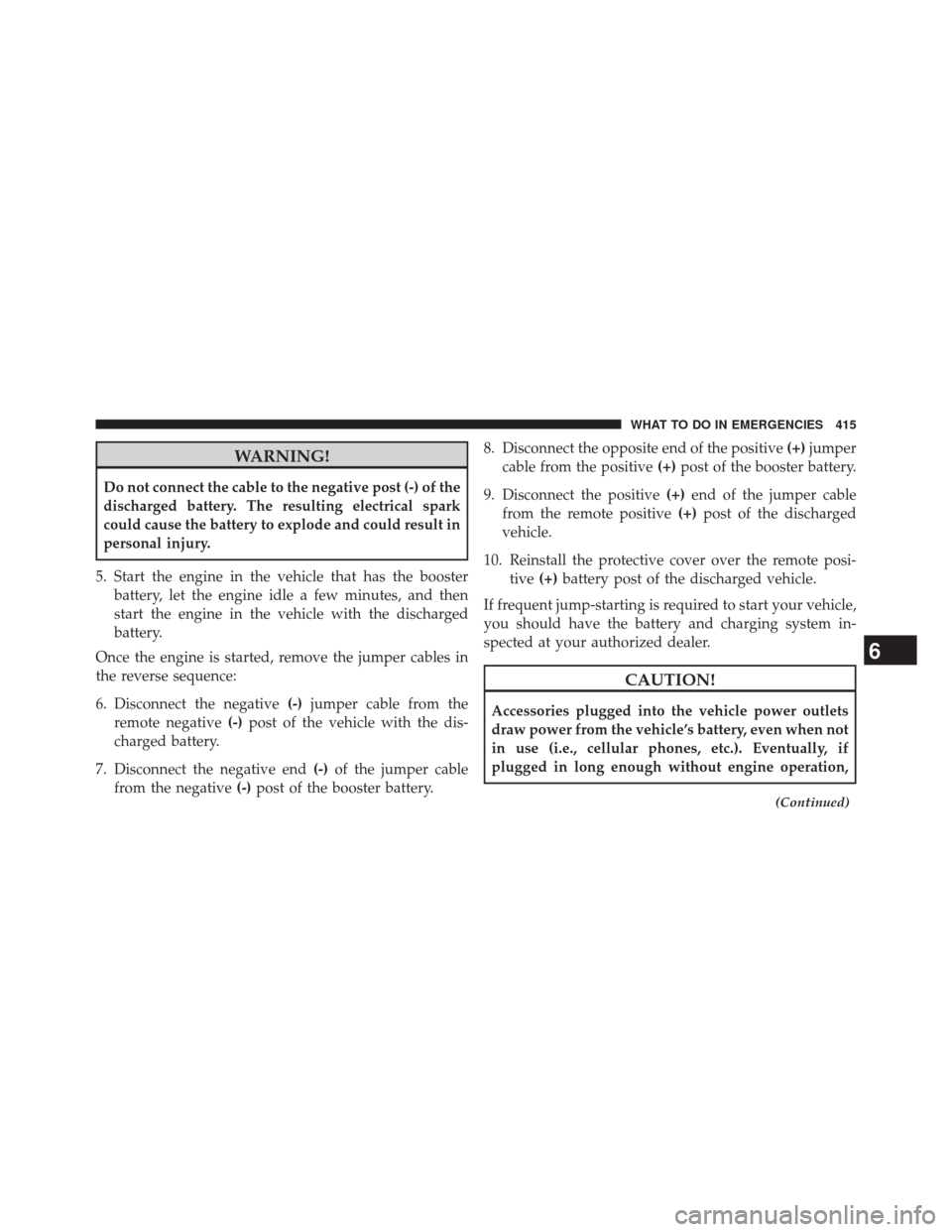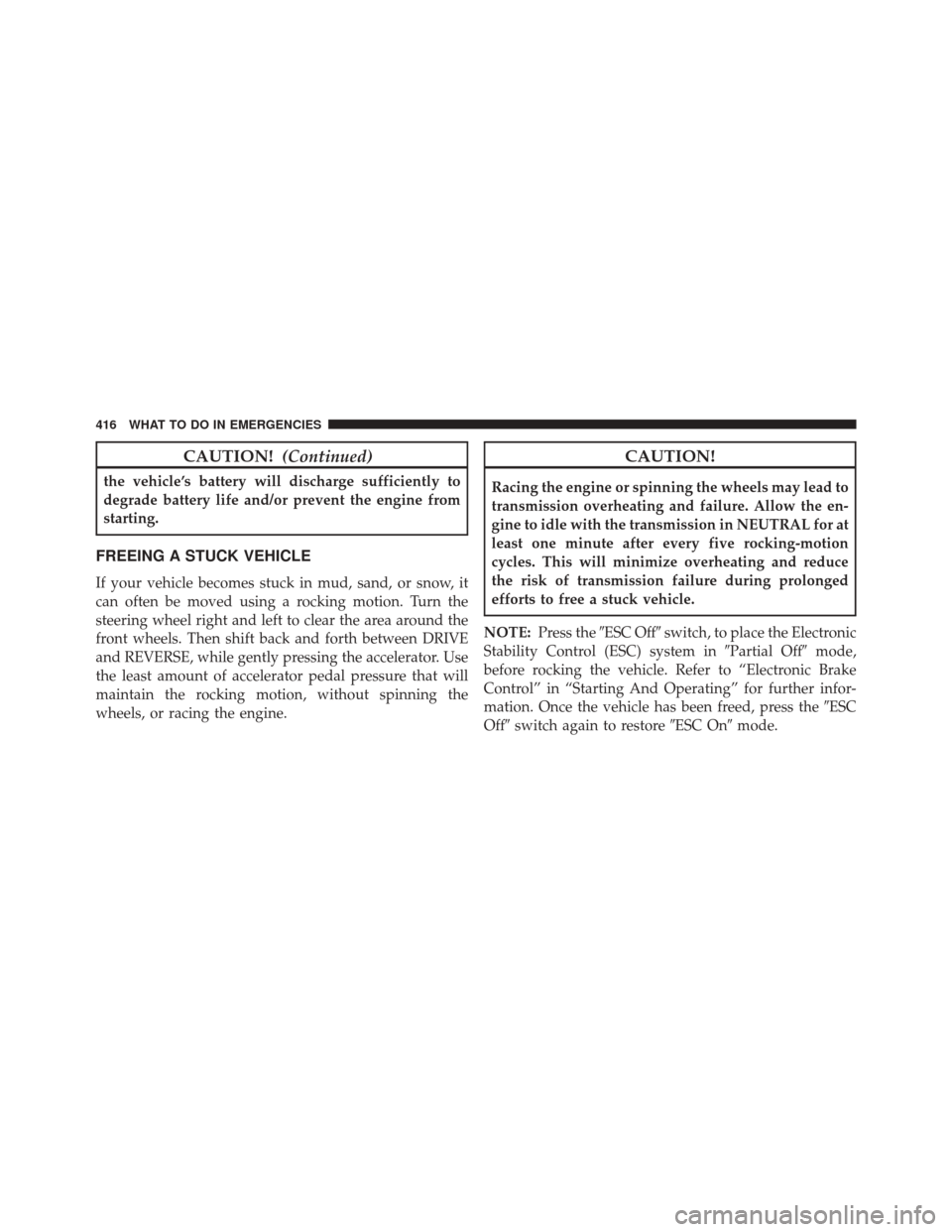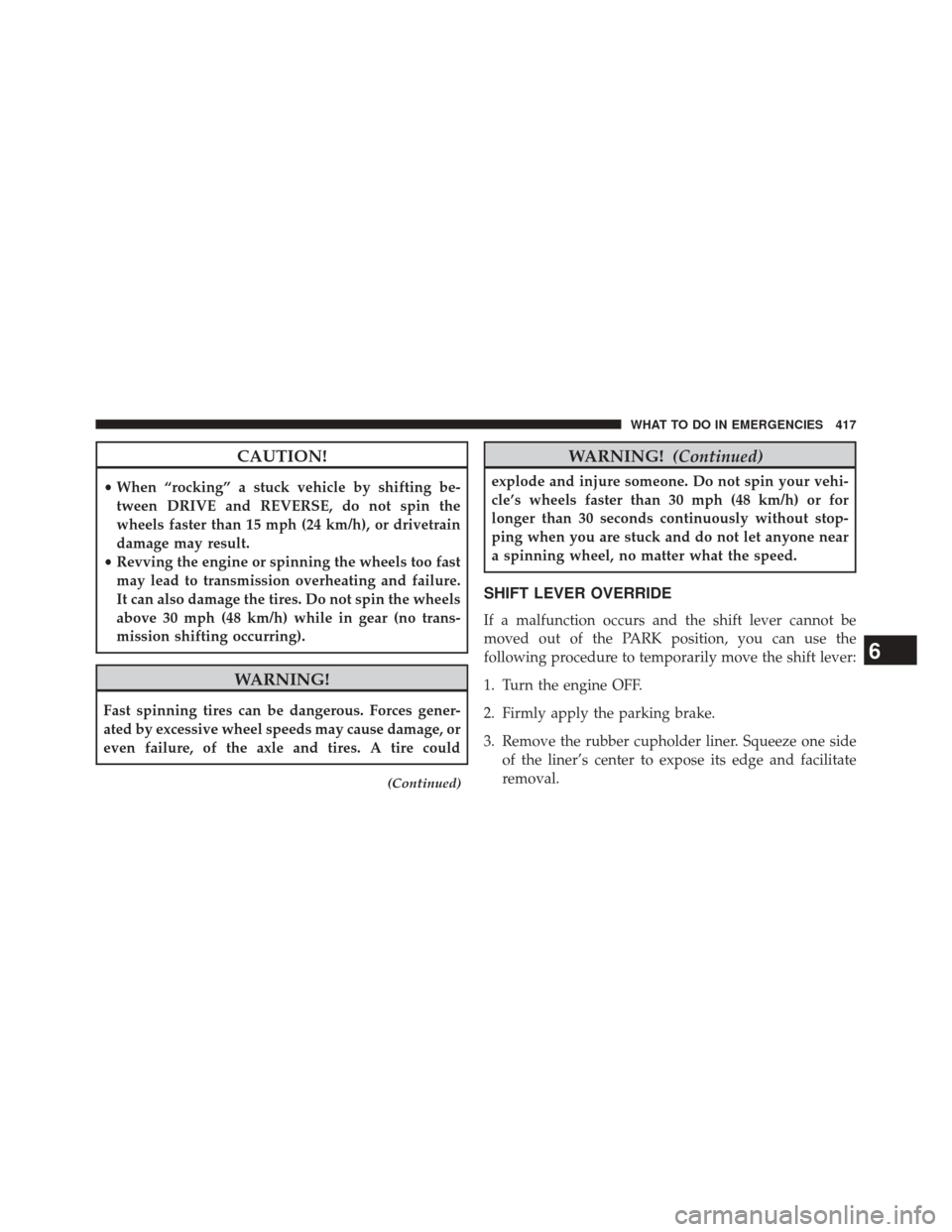Page 417 of 522

WARNING!
Do not connect the cable to the negative post (-) of the
discharged battery. The resulting electrical spark
could cause the battery to explode and could result in
personal injury.
5. Start the engine in the vehicle that has the booster battery, let the engine idle a few minutes, and then
start the engine in the vehicle with the discharged
battery.
Once the engine is started, remove the jumper cables in
the reverse sequence:
6. Disconnect the negative (-)jumper cable from the
remote negative (-)post of the vehicle with the dis-
charged battery.
7. Disconnect the negative end (-)of the jumper cable
from the negative (-)post of the booster battery. 8. Disconnect the opposite end of the positive
(+)jumper
cable from the positive (+)post of the booster battery.
9. Disconnect the positive (+)end of the jumper cable
from the remote positive (+)post of the discharged
vehicle.
10. Reinstall the protective cover over the remote posi- tive (+)battery post of the discharged vehicle.
If frequent jump-starting is required to start your vehicle,
you should have the battery and charging system in-
spected at your authorized dealer.
CAUTION!
Accessories plugged into the vehicle power outlets
draw power from the vehicle’s battery, even when not
in use (i.e., cellular phones, etc.). Eventually, if
plugged in long enough without engine operation,
(Continued)
6
WHAT TO DO IN EMERGENCIES 415
Page 418 of 522

CAUTION!(Continued)
the vehicle’s battery will discharge sufficiently to
degrade battery life and/or prevent the engine from
starting.
FREEING A STUCK VEHICLE
If your vehicle becomes stuck in mud, sand, or snow, it
can often be moved using a rocking motion. Turn the
steering wheel right and left to clear the area around the
front wheels. Then shift back and forth between DRIVE
and REVERSE, while gently pressing the accelerator. Use
the least amount of accelerator pedal pressure that will
maintain the rocking motion, without spinning the
wheels, or racing the engine.
CAUTION!
Racing the engine or spinning the wheels may lead to
transmission overheating and failure. Allow the en-
gine to idle with the transmission in NEUTRAL for at
least one minute after every five rocking-motion
cycles. This will minimize overheating and reduce
the risk of transmission failure during prolonged
efforts to free a stuck vehicle.
NOTE: Press the �ESC Off� switch, to place the Electronic
Stability Control (ESC) system in �Partial Off�mode,
before rocking the vehicle. Refer to “Electronic Brake
Control” in “Starting And Operating” for further infor-
mation. Once the vehicle has been freed, press the �ESC
Off� switch again to restore �ESC On�mode.
416 WHAT TO DO IN EMERGENCIES
Page 419 of 522

CAUTION!
•When “rocking” a stuck vehicle by shifting be-
tween DRIVE and REVERSE, do not spin the
wheels faster than 15 mph (24 km/h), or drivetrain
damage may result.
• Revving the engine or spinning the wheels too fast
may lead to transmission overheating and failure.
It can also damage the tires. Do not spin the wheels
above 30 mph (48 km/h) while in gear (no trans-
mission shifting occurring).
WARNING!
Fast spinning tires can be dangerous. Forces gener-
ated by excessive wheel speeds may cause damage, or
even failure, of the axle and tires. A tire could
(Continued)
WARNING! (Continued)
explode and injure someone. Do not spin your vehi-
cle’s wheels faster than 30 mph (48 km/h) or for
longer than 30 seconds continuously without stop-
ping when you are stuck and do not let anyone near
a spinning wheel, no matter what the speed.
SHIFT LEVER OVERRIDE
If a malfunction occurs and the shift lever cannot be
moved out of the PARK position, you can use the
following procedure to temporarily move the shift lever:
1. Turn the engine OFF.
2. Firmly apply the parking brake.
3. Remove the rubber cupholder liner. Squeeze one side
of the liner’s center to expose its edge and facilitate
removal.
6
WHAT TO DO IN EMERGENCIES 417
Page 420 of 522
4. Turn the ignition to the ACC or ON/RUN position,but do not start the engine.
5. Press and maintain firm pressure on the brake pedal.
6. Insert a screwdriver or similar tool into the access hole (at the front of the cupholder) and push and hold the
override release lever forward. 7. Move the shift lever to the NEUTRAL position.
8. The vehicle may then be started in NEUTRAL.
9. Reinstall the cupholder liner.
TOWING A DISABLED VEHICLE
This section describes procedures for towing a disabled vehicle using a commercial wrecker service.
Towing Condition
Wheels OFF the Ground All Models
Flat Tow NONEIf transmission is operable:
• Transmission in NEUTRAL
• 25 mph (40 km/h) maxspeed
• 15 mi (24 km) maxdistance
Wheel Lift Or Dolly Tow
Rear
Front OK
Flatbed ALLBEST METHOD
418 WHAT TO DO IN EMERGENCIES
Page 423 of 522
MAINTAINING YOUR VEHICLE
CONTENTS
�ENGINE COMPARTMENT — 2.4L ..........423
� ENGINE COMPARTMENT — 3.6L ..........424
� ONBOARD DIAGNOSTIC SYSTEM — OBD II . .425
▫ Loose Fuel Filler Cap Message ............425
� EMISSIONS INSPECTION AND MAINTENANCE
PROGRAMS ......................... .426
� REPLACEMENT PARTS ..................427
� DEALER SERVICE ..................... .427
� MAINTENANCE PROCEDURES ...........428
▫ Engine Oil ......................... .429▫
Engine Oil Filter ..................... .432
▫ Engine Air Cleaner Filter ................432
▫ Maintenance-Free Battery ...............433
▫ Air Conditioner Maintenance .............435
▫ A/C Air Filter – If Equipped .............436
▫ Body Lubrication .....................437
▫ Windshield Wiper Blades ...............438
▫ Adding Washer Fluid ..................438
▫ Exhaust System ..................... .439
▫ Cooling System ..................... .442
7
Page 424 of 522
▫Brake System ....................... .448
▫ Automatic Transmission ................450
▫ Appearance Care And Protection From Corrosion
................................. .454
▫ Cleaning Center Console Cupholders ........459
▫ Convertible Top Care ...................460
▫ Weather Strip Care – Soft And Hard Top .....462
� FUSES ............................. .463
▫ Integrated Power Module ...............464
� VEHICLE STORAGE ....................470
� REPLACEMENT BULBS .................470 �
BULB REPLACEMENT ..................471
▫ Headlamp ......................... .471
▫ Front Turn Signal .....................474
▫ Front Fog Lamp ..................... .475
▫ Backup Lamps ...................... .475
▫ License Plate Lamp ....................477
� FLUID CAPACITIES ....................477
�
FLUIDS, LUBRICANTS AND GENUINE PARTS . .478
▫ Engine ............................ .478
▫ Chassis ........................... .480
422 MAINTAINING YOUR VEHICLE
Page 425 of 522
ENGINE COMPARTMENT — 2.4L
1 — Engine Coolant Reservoir5 — Integrated Power Module (Fuses) 9 — Coolant Pressure Cap
2 — Power Steering Fluid Reservoir 6 — Power Distribution Center (Fuses) 10 — Engine Oil Dipstick
3 — Automatic Transmission Dipstick 7 — Air Cleaner Filter 11 — Washer Fluid Reservoir
4 — Brake Fluid Reservoir 8 — Engine Oil Fill
7
MAINTAINING YOUR VEHICLE 423
Page 426 of 522
ENGINE COMPARTMENT — 3.6L
1 — Engine Coolant Reservoir5 — Air Cleaner Filter
2 — Power Steering Fluid Reservoir 6 — Engine Oil Dipstick
3 — Brake Fluid Reservoir 7 — Engine Oil Fill
4 — Integrated Power Module (Fuses) 8 — Washer Fluid Reservoir
424 MAINTAINING YOUR VEHICLE